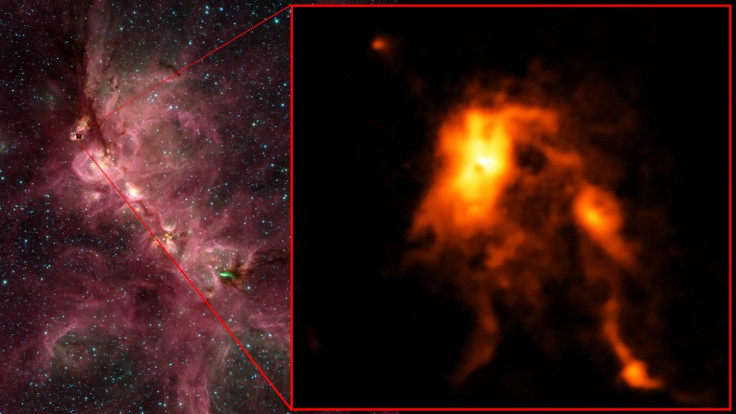Outburst In Cat's Paw Nebula Sheds Light On Star Formation

Stars form when clouds of dust and gas reach temperatures that are low enough to permit condensation and gravitational collapse. This process is slow and painstaking and can take anywhere between 100,000 to 10 million years — unless something makes young stars undergo a period of intense growth spurt.
A team of astronomers using the Atacama Large Millimeter/submillimeter Array (ALMA) in Chile and the Submillimeter Array (SMA) in Hawaii has observed something like this happening in a nebula located 5,500 light-years from Earth. Observations have revealed that a small portion of the Cat’s Paw Nebula (also known as NGC 6334) is forming stars at a much faster rate than expected — a phenomenon that has made the region much brighter than it was before.
“By studying a dense star-forming cloud with both ALMA and the SMA, we could see that something dramatic had taken place, completely changing a stellar nursery over a surprisingly short period of time,” Todd Hunter, an astronomer at the National Radio Astronomy Observatory, and lead author of a recent paper detailing the observations, said in a statement.
So what is happening in the Cat’s Paw Nebula? A new ALMA image provides some clues.
The image reveals that a massive protostar nestled deep within the star-forming region in the nebula is undergoing a massive growth spurt — most likely triggered by an “avalanche” of gas and dust — that has dramatically increased its luminosity. This avalanche itself may have been triggered by a larger-than-usual clump of debris being drawn into the star’s accretion disk.
This is the first time such an event has been observed at millimeter wavelengths.
“These observations add evidence to the theory that star formation is punctuated by a sequence of dynamic events that build up a star, rather than a smooth continuous growth,” Hunter said. “It also tells us that it is important to monitor young stars at radio and millimeter wavelengths, because these wavelengths allow us to peer into the youngest, most deeply embedded star-forming regions. Catching such events at the earliest stage may reveal new phenomena of the star-formation process.”
© Copyright IBTimes 2025. All rights reserved.






















